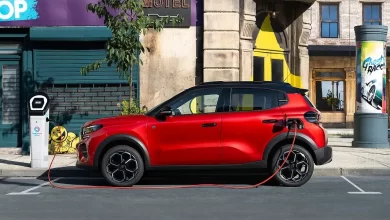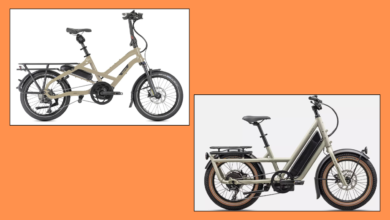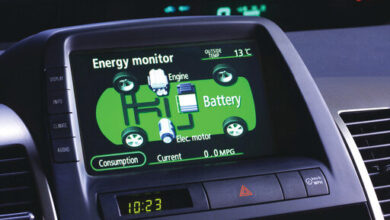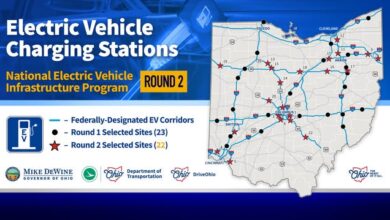How To Find EV Charging Stations

If you drive a gas-powered car, chances are you don’t plan your trips around finding a gas station. It’s not just that gas stations are everywhere. You also don’t have to worry whether the pumps will work or how fast you’ll be able to fill your car.
Making efficient use of EV chargers on the road requires more thought. They aren’t as ubiquitous as gas stations and they are also less reliable. That means navigating to what turns out to be a broken charger isn’t just frustrating—if you’re low on range, it’s potentially disastrous. And chargers aren’t one-size-fits-all; some aren’t compatible with all vehicles, or you may need an adapter to hook up your car, a mobile app to start the charging, or both. Plus, of course, chargers come in different speeds. On a last note, chargers can be hard to find, in addition to being painful to miss. They don’t tend to come with 30-foot signs displaying their location and price, and are often located in the back of shopping centers and hotel parking lots.
Complicating all of this, a huge amount of public and private money is being invested in EV charging solutions, resulting in a lot of experimentation as local and state governments, car makers, charging companies, and even payment platforms try to figure out what works and what doesn’t. For consumers, that translates into a potentially confusing array of options when it comes to something as basic as locating chargers.
Should you use an app or your in-car navigation system? Why bother with CarPlay? The answer depends on the nature of your trip, what kind of car you drive, and whether getting charged is your only goal or just one.
Finding a Working Charger: PlugShare and Other Mobile Apps
Fifteen years after its creation, the PlugShare app (and website) still remains one of the most reliable sources of information for finding a working charger that meets your specific needs. Think of PlugShare as the Yelp of EV charger hunting: it allows you to filter stations by speed, plug type, number of chargers, nearby amenities, or any other factor that might be relevant to your decision. While the EPA also maintains a very similar map, Plugshare improves on this by showing recent check-ins from other users, allowing you to see if people are successfully charging, whether one particular charger is slow, or whether the site is down entirely. All of that makes PlugShare ideal for discrete searches, like locating the nearest fast charge station, or finding out whether there is a level 2 charger near your hotel. (As an aside, Plugshare is also generally your best bet for locating publicly available 240-volt outlets, like those in RV campgrounds.)
Plugshare is as developed as it is because it supported drivers in the earliest days of EVs, when finding a charger on the road was much more harrowing than it is today. Most EVs didn’t have navigation systems, let alone systems that could direct you to a specific charger. Fast chargers were exceedingly rare and most cars couldn’t use them, and slow chargers, too, were few and far between. So the early adopters were resourceful and created tools to help other drivers find places to plug in. In the early days, Plugshare users even listed their own home chargers so that other EV owners could use them. PlugShare can also be worth a look if you’re curious about upcoming chargers. Intrepid investigators in the Tesla Motors Club forum have gone so far as to search public records for construction permits for upcoming Supercharger locations, reporting them on Plugshare when found.
PlugShare is far from the only charger database out there. Its closest competitor is ChargeHub, an app that provides virtually identical functionality. Though ChargeHub has far fewer users writing reviews of chargers, the user interface is a bit more modern and it features fewer ads, so choosing between the two apps is a matter of preference more than anything else.
Both PlugShare and ChargeHub aggregate chargers from all networks, which is an advantage if you want the most comprehensive view of what’s available in a given area. But if you are highly dependent on public chargers–either because you don’t have at-home charging or spend a lot of time on the road–then chances are you are subscribed to a charging network for discounted use. In that case, it can make sense to use the app provided by your EV-preferred charging provider, such as Electrify America, EVgo, or Chargepoint. As might be expected, these apps often are the best source of real-time status information for chargers in their network and can be very helpful for purposes of assessing availability and avoiding congestion at a station, and will generally need to be used to initiate the charge anyway.
Planning a Trip: A Better Route Planner
The app you use to find a working charger near you is not necessarily the app you want to use to plan a trip. PlugShare has a trip planning functionality, but it’s not as smart as some of the other options, requiring you to input your starting range and manually select from the available options at each charging stop along the way. It also doesn’t factor in live traffic along the way or guide you there in real time. That makes navigating a multi-stop road trip with PlugShare tedious, akin to printing directions in the MapQuest days.
For long trips, A Better Route Planner (ABRP) is the best mobile app solution. You simply add your vehicle and starting range, set your destination, and it will take you to all of your charging stops along the way optimizing for the shortest total time or number of charging stops if you prefer. You are able to filter to use only particular charging networks or avoid any, as well as factor in charger availability(with a premium subscription). Once on your way, the app shows a predicted state of charge of your battery. If you find this to be inaccurate, potentially due to weather, you can change it in the app and it will adjust your route as necessary. Unlike in-car systems however, the responsibility of keeping that state of charge up to date in the app lies with you, and failure to do so can result in not being able to reach the next charger at all. Despite that caveat, ABRP is a very complete EV road trip tool.
Whether you’re in an older car without an in-car navigation system, one whose systems you are less familiar with, or simply want to be sure you know the location and status of all the charging options around you, these apps can serve an important purpose in your charging experience.
Planning a Trip with Integrated Data: In-Car Navigation in a Tesla
Every Tesla owner knows the advantages of integrated data. An app may give you optionality but you are still left to calculate, for yourself, whether you can make it to a particular charger. Tesla takes care of that problem by providing you with a car that monitors its own battery depletion and directs you to an optimally located Supercharger.
Most EVs sold today have some form of in-car navigation system, and many of these, too, are able to direct you to nearby EV chargers, or help you plan charge stops along a route. But with these systems, the devil is in the details. Tesla’s Trip Planner remains the strongest and most seamless of these systems because it has spent years investing in a vertically integrated charging network that optimizes trip planning and automates the payment process. By default, the Trip Planner map shows nearby Supercharger stations, allowing you to simply set them as your destination. As with ABRP, if you set a destination that is beyond the range of your vehicle, Trip Planner will optimize the route, directing you to Supercharger stations along the way, telling you how long you need to charge to reach the next stop in the most time efficient (if slightly range-conservative) way. Thanks to its vertically integrated network, Tesla also avoids routing you to broken or busy stations that may result in an unnecessary wait to charge.
The downside of this system is that Trip Planner will incorporate only Tesla’s Superchargers into your route. Tesla’s navigation map also shows its own level 2 chargers, and third-party chargers if you’ve charged at those particular locations before (making Plugshare your best option for locating all of the available options). For now, the limitation isn’t unduly problematic for most Tesla owners, for two reasons. First, third-party fast charging networks in the U.S. currently require a CCS-to-NACS adapter, which most Tesla owners simply do not have. Second, Tesla has the largest and most reliable fast charger network by far. But as other networks close the gap (and adopt NACS), Tesla will likely open up Trip Planner, as more optionality is always better for drivers planning a route. In fact, Tesla has already started doing this in other countries.
Planning a Trip with Integrated Data: In-Car Navigation in a Non-Tesla
At first blush, other OE systems, like Ford’s Fordpass navigation and charging system, appear to offer functionality similar enough to Tesla’s, but in practice, their lack of real-time data from third-party networks has resulted in a poor charging experience for their users. In Marques Brownlee’s road trip test a couple years ago, Ford’s navigation system directed a Mustang Mach-E to broken chargers twice in one day. That forced the car to backtrack to whatever charger it could find within the remaining range of the vehicle–including to a slow level 2 charger–adding up to hours-long delays.
In the face of these challenges, car makers have started looking to the tech world for route planning solutions. For instance, last year, Rivian purchased the parent company of A Better Route Planner and has since integrated the best of ABRP’s functionality into its navigation system. Much like Tesla’s system, it plans your charging stops along the way, and allows you to filter locations based on charging speed and charging provider. Unlike the general ABRP mobile app, Rivian’s system pulls information about the state of your battery charge directly from your vehicle. It also allows you to set the amount of charge you would like to have by the time you arrive at your destination and tracks real-time availability data from many third-party charging providers (though not all providers share this information).
Some manufacturers, like Polestar, rely on Google Maps, which has added EV routing integration into the automotive version of its Maps app. This partnership enables the car’s infotainment system to provide functionality similar to Rivian’s ABRP software, combined with Google’s live traffic routing. Polestar also boasts that ABRP is available on its vehicles, giving owners multiple options for seamless routing.
Mobile Apps as In-Car Navigation
Looking to the near future, what is likely to become popular are phone-based solutions like Apple CarPlay and Android Auto which use your phone to create an in-car navigation experience. In other words, they allow your phone to pull information from the vehicle and display mobile apps on the infotainment screen. This enables applications running on your phone to understand the range and state of charge of your vehicle, and offer similar functionality to ones running on the car’s infotainment system. If your EV allows CarPlay/Android Auto apps to read this data, you can use EV routing software available on the app store, notably Apple Maps, Google Maps, or ABRP. All of these apps have proven to be very robust and full-featured, and will likely continue to improve as more charging providers share their data with the tech giants. The caveat is that compatibility is up to the car makers, at least for the foreseeable future (though ABRP does have an OBD-based workaround).
Ford and Porsche have leaned into this functionality, but Hyundai and Kia currently do not support this integration, instead releasing their own route planner last summer. GM also announced last year that they would be phasing out CarPlay and Android Auto in favor of developing their own system with Google. Tesla does not support CarPlay or Android Auto at all.
Charging While Shopping: Retail and Hospitality Chains
It’s fun to dream about a future where driving an EV requires as little planning as an ICE vehicle. It will take some time before chargers are on every street corner, but retailers are taking steps toward that reality.
The big shift we should expect is a movement toward charging-while-[fill in the blank]. Increasingly, retailers are understanding that offering EV charging is an easy way to bring people to their businesses. Having a captive audience for 20 minutes to an hour is an enticing proposition, and as shown by a recent Consumer Reports study, many companies are offering charging to stimulate brick-and-mortar sales.
The earliest and most complete mover in this arena is Ikea. It should come as no surprise that the flat-pack furniture retailer hailing from the country with one of the highest rates of EV adoption in the world has long offered charging at its locations. Currently nearly all of its U.S. facilities have at least a handful of chargers in their vast parking lots.
Big box retailers are also starting to invest in charging, though that doesn’t mean you can reliably expect to see chargers at a given location just yet. Costco, Target, and Walmart all have EV charging at fewer than 10 percent of their locations, and many of Electrify America’s fast charge stations are located in Walmart lots.
The major national grocery chains have gone further. Amazon/Whole Foods, Big Y, Meijer, Giant, Food Lion, Stop & Shop, Hy-Vee, and Raley’s all boast chargers at between 11 and 30 percent of their locations. Meijer, in particular, hosts many Tesla Superchargers in the midwest, while Raley’s maintains a number of EVgo fast charge locations.
Sheetz and Wawa lead the convenience store pack, largely through their work with Tesla hosting superchargers up and down the East Coast. The competing chains also both work with EVgo to provide CCS and CHAdeMo charging as well.
Hotel chains are perhaps the businesses with the most to gain, or lose, from the decision on whether to offer charging. Having access to a level 2 charger overnight can mean saving over an hour of charging on your journey, and many EV owners will choose hotels that make that possible. So it’s unsurprising that hotels have been moving quickly to add this amenity, often as a free perk for guests. Hilton announced last year that it plans to work with Tesla to install 20,000 chargers across 2,000 hotels in North America, adding to the nearly 1,500 hotels that already have them. Marriott has more than 6,000 chargers worldwide through a partnership with EVconnect. Radisson and Best Western have also announced that they are working with Tesla to increase their EV footprint.
The bottom line: As with gas stations, with a little trial and error, you will quickly find the handful of chargers where you’ll do the vast majority of your charging. For the rest, your car and your circumstances will largely dictate which app, navigation system, or in-between option provides you the best real-time data on working chargers at minimally congested sites.
An aerospace engineer with a life-long passion for anything with wheels or wings, Will has spent his career building everything from bicycles to bathrooms.
He once ran an after-hours communal car workshop in an abandoned South Bronx laundromat, restoring his first and last car, a Datsun 240z, and had a Suzuki SV650 blown up by ConEd.
Watts later followed his name and joined Tesla’s charging team, and now writes about EVs and infrastructure.



